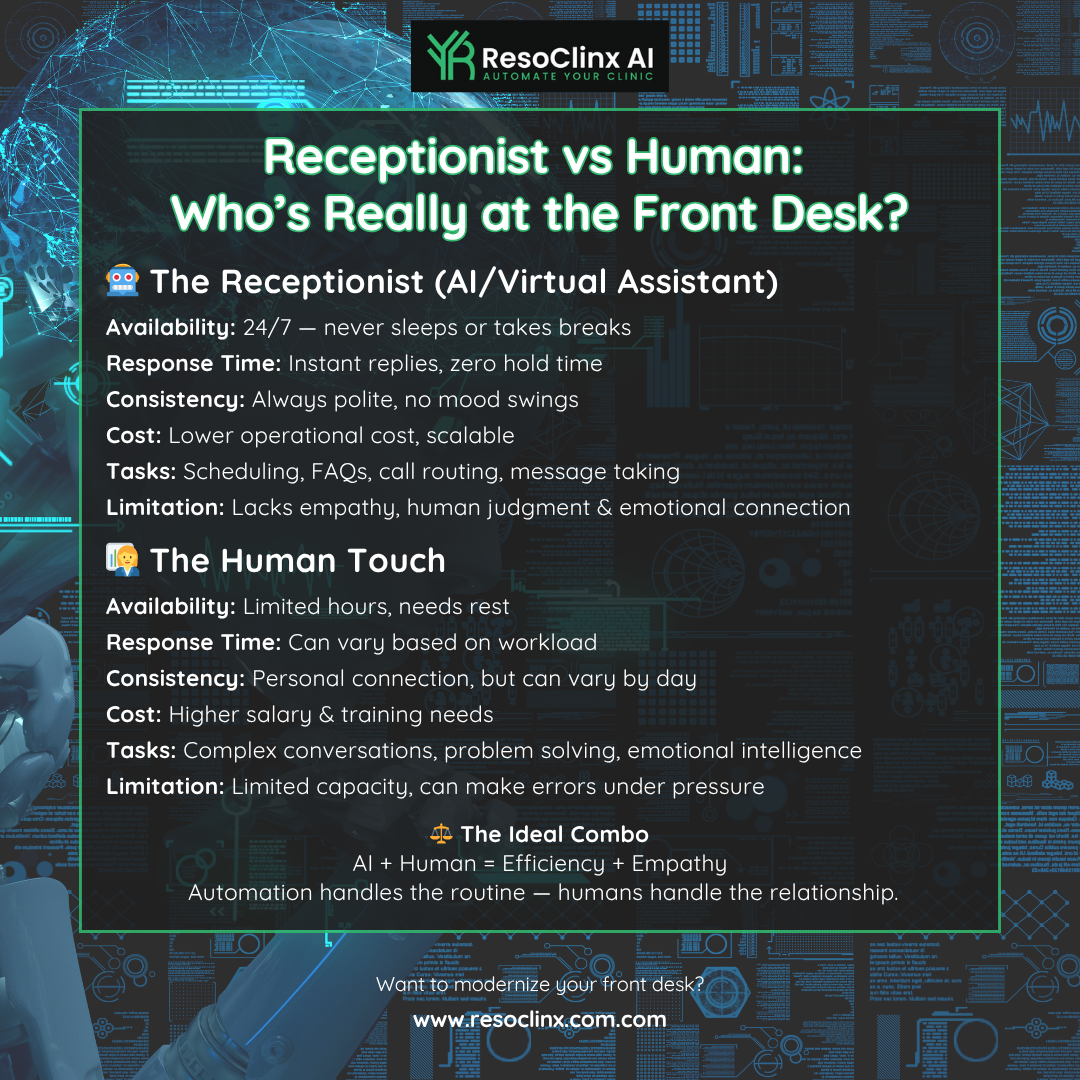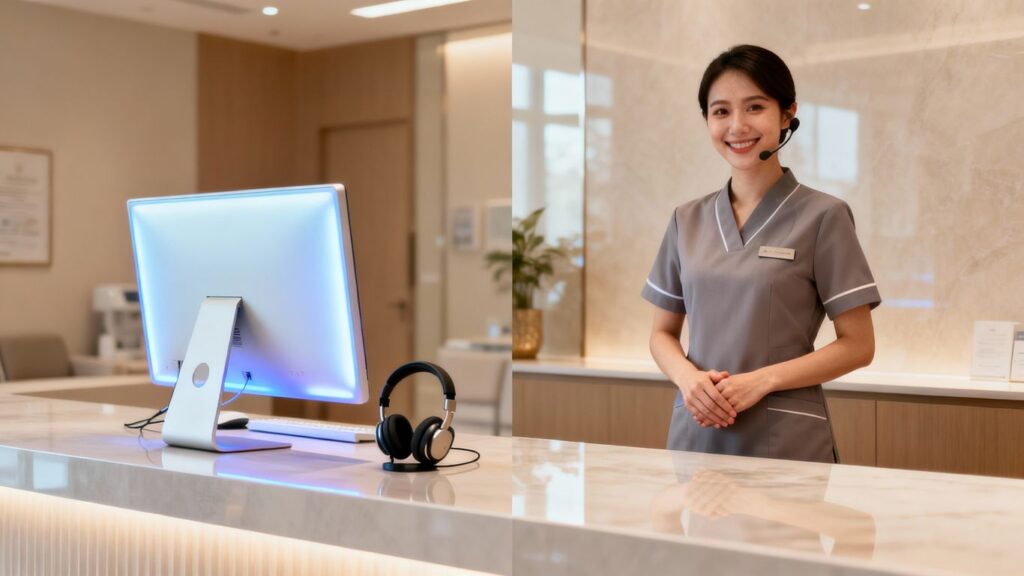Choosing between a virtual receptionist and a human receptionist is a significant decision for any aesthetic clinic. Each option brings clear strengths; the right choice depends on whether you prioritise efficiency, patient experience, or cost-effectiveness.
This guide breaks down the key differences, benefits, and trade-offs so you can decide which approach best supports clinic growth and patient satisfaction.
Key Takeaways
- 24/7 Support: A virtual receptionist offers round-the-clock availability, ensuring no enquiry or booking request is missed — ideal for improving accessibility and patient convenience.
- Human Connection: A skilled in-house receptionist brings empathy and warmth, helping build trust and rapport with patients seeking aesthetic treatments.
- Operational Efficiency: Virtual receptionists reduce administrative workload and overhead costs, allowing your team to focus on patient care.
- Balanced Approach: While automation delivers speed and cost savings, the human element remains essential for handling sensitive conversations and nurturing long-term relationships.
- Strategic Decision: The best solution depends on your clinic’s goals — balancing consistent availability with a personalised, brand-aligned patient experience.
Understanding The Core Differences: Virtual Receptionist vs Human

The first point of contact sets the tone for the entire patient journey. It goes beyond answering the phone; every caller should feel heard, understood and genuinely cared for.
This is where the difference between a virtual receptionist and a human receptionist becomes crucial to your clinic’s success.
Defining The Virtual Receptionist Role
A virtual receptionist is a remote service or AI-powered system that manages calls, appointment scheduling, and basic patient queries. Designed for high-volume communication, it ensures your clinic remains accessible even outside standard hours.
Think of it as your automated front line — handling routine enquiries and admin tasks efficiently so your in-house team can focus on more complex or patient-facing responsibilities.
The Indispensable Human Touch
A human receptionist, whether based in-clinic or working remotely, offers something technology simply can’t replicate — empathy, intuition, and genuine human understanding.
Patients exploring aesthetic treatments are often making deeply personal decisions about their appearance and confidence. A compassionate receptionist can recognise emotions, respond with warmth, and create the sense of trust that underpins every successful patient relationship.
Key Differentiators For Aesthetic Clinics
In aesthetic clinics, these differences are especially clear. While virtual systems can efficiently handle routine bookings, they often lack the ability to interpret emotional nuances or offer tailored advice.
A human receptionist can:
- Listen actively to patient concerns and identify emotional cues.
- Offer empathy and reassurance, particularly during sensitive or confidence-related discussions.
- Handle complex or unexpected questions with professionalism and understanding.
- Build rapport, making patients feel genuinely valued and at ease.
Technology brings speed and consistency, but the human element builds trust — and in aesthetics, trust is what turns first-time callers into loyal clients.
Enhancing Patient Experience: A Comparative Look
When a patient walks into your clinic, or even just calls up, they’re looking for more than just a treatment. They want to feel looked after, understood, and confident in the service they’re about to receive.
This is where the experience you provide really counts, and it’s a big part of why they’ll choose you over someone else. Let’s break down how virtual receptionists and human receptionists stack up when it comes to making patients feel good.
Consistency and Availability
One of the biggest plus points for a virtual receptionist service is its sheer availability. They can be there for your patients around the clock, or at least for extended hours that might be hard for a small clinic to manage in-house. This means no missed calls, no unanswered emails during busy periods, and a consistent point of contact for patients whenever they need it.
On the flip side, a human receptionist, while potentially offering a more personal touch, might have limitations. Their availability is usually tied to clinic hours, and things like holidays, sickness, or even just a busy lunch rush can mean patients have to wait.
This consistent availability can be a real game-changer for patient satisfaction, especially for those who are researching treatments outside of typical working hours.
Personalised Interaction and Empathy
This is where the human touch really shines. A skilled human receptionist can pick up on a patient’s tone of voice, understand their concerns, and respond with genuine empathy. They can build a rapport that makes a patient feel truly heard and cared for.
This is especially important in aesthetic clinics, where patients might be feeling a bit vulnerable or anxious about their treatments. A warm, understanding voice on the other end of the phone can make all the difference.
Virtual receptionists, while becoming more sophisticated, often struggle to replicate this level of emotional connection. They can follow scripts and provide information efficiently, but that intuitive understanding and empathetic response is something that’s hard to program. It’s the difference between being processed and being cared for.
Building Trust and Rapport
Trust is everything in the aesthetic industry. Patients are entrusting you with their appearance and their well-being. The initial interactions they have with your clinic play a huge role in building that trust.
A friendly, professional, and knowledgeable human receptionist can create a positive first impression that sets the stage for a great patient journey. They can answer questions thoroughly, offer reassurance, and make the patient feel comfortable from the very first contact.
While virtual systems can be efficient, they might sometimes feel a bit impersonal. If a patient has a complex question or a unique concern, a pre-programmed response might not cut it. Building that deep sense of trust often comes from knowing you’re speaking to a real person who understands your specific situation.
Here’s a quick look at how they compare:
| Feature | Human Receptionist |
|---|---|
| Availability | Limited to clinic hours, staff schedules |
| Consistency | Can vary, depends on individual training and mood |
| Empathy/Personal Touch | High, can offer genuine understanding and warmth |
| Rapport Building | Strong potential for personal connection and trust |
| Handling Complex Issues | Can adapt, understand nuance, and offer reassurance |
Operational Efficiency: Streamlining Clinic Workflow

Busy aesthetic clinics juggle patient care, treatment delivery and business growth.
That’s where optimising your workflows comes in handy. It’s about making sure everything runs smoothly, from the first enquiry to the final follow-up, freeing you and your staff up to focus on what matters most: patient care.
Appointment Management Excellence
Getting appointments booked and managed efficiently is key. Think about how much time your team spends on the phone, scheduling, rescheduling, or sending reminders. A virtual receptionist or smart scheduling software can take over a lot of this.
Clinics commonly regain meaningful admin time each week by offloading these tasks. This means your clinical staff can spend more time with patients, focusing on treatments and building those important relationships, instead of being tied up with administrative duties.
- Automated Appointment Confirmations: Reduce no-shows by sending instant confirmations.
- Intelligent Rescheduling Options: Allow patients to easily adjust appointments online or via a quick call.
- Pre-Appointment Information Delivery: Send out necessary forms or instructions beforehand to save time on the day.
Handling Inquiries and Lead Generation
Every enquiry is a potential patient, and how you handle it can make a big difference. Quick, professional responses are vital, especially in a competitive field like aesthetics.
A virtual receptionist can answer common questions, gather initial information and qualify leads. Rapid follow-up is key to converting interest into actual appointments.
Prompt responses across phone, email and forms directly improve conversion rates and growth.
Reducing Administrative Burden
Think about all the little tasks that add up: processing payments, sending out invoices, managing patient records. These can all be streamlined. Virtual receptionists can trigger secure payment links and confirm receipt (subject to your payment provider and clinical policies).
It means less paperwork for your clinic staff and a smoother process for your patients. By automating or delegating these tasks, you create a more efficient operation and give your team more time to focus on delivering exceptional patient experiences.
Here’s how tasks can be managed:
- Appointment Booking: Automated systems or virtual assistants can manage your schedule.
- Payment Processing: Secure online payments and automated invoicing.
- Lead Qualification: Initial screening of new enquiries to identify serious prospects.
- Patient Record Updates: Basic data entry and organisation of patient information.
Cost-Effectiveness: Strategic Investment for Growth

When you run an aesthetic clinic, every pound must work hard. Hiring a full-time in-house receptionist is a significant cost—salary, benefits, training and overhead.
Thinking about costs isn’t just about cutting corners; it’s about making smart choices that pay off in the long run. This is where understanding the financial side of things, whether you’re looking at virtual receptionists or other operational aspects, becomes really important.
Evaluating The Financial Implications
Let’s be honest, hiring a full-time, in-house receptionist is a significant expense. You’ve got the salary, the benefits, the training, and all the overheads that come with having another person on staff. It adds up quickly.
Virtual receptionists, on the other hand, often present a much more budget-friendly alternative. Typically, you’re paying for the service you actually use, and many clinics reduce costs compared with a full-time hire, especially when factoring in benefits, training and cover. Plus, you sidestep all those hidden costs associated with staff turnover, like recruitment and the inevitable gaps in knowledge when someone leaves.
It’s a really sensible way to keep your budget in check while still getting the support you need. But it’s not just about saving money; it’s also about making more. When your clinic is busy and the phone is ringing off the hook, you’re potentially missing out on new patients. A virtual receptionist can catch those calls, respond to queries promptly, and even help secure deposits or consultation bookings.
Some services can even be trained to upsell products or special promotions. Capturing those leads that might otherwise slip away can lead to a noticeable increase in new patients each month, directly boosting your clinic’s income. It’s about making sure every potential client gets a response and has a smooth path to booking their first appointment.
Scalability and Resource Allocation
One of the big advantages of using a virtual receptionist service is how easily it can scale with your clinic’s needs. If you have a sudden surge in bookings or a new marketing campaign brings in a lot of enquiries, you can often adjust your service level without the hassle of hiring and training new staff.
This flexibility means you’re not overspending on resources when things are quiet, but you’ve also got the capacity to handle busy periods without dropping the ball. It’s about allocating your resources smartly, ensuring you have the right level of support exactly when you need it.
Think about it like this:
- Peak periods: Increase virtual reception capacity during promotions or seasonal spikes.
- Quieter weeks: Scale back to avoid unnecessary spend.
- Expansion: Add capacity as you add services or practitioners without re-building your admin team.
This adaptability is key for managing your budget effectively and ensuring that your administrative support is always aligned with your clinic’s operational demands.
Maximising Return on Investment
Ultimately, the goal is to make sure that any money you spend on your front-of-house operations gives you the best possible return. When a virtual receptionist service is set up correctly, it’s not just an expense; it’s an investment that can actively contribute to your clinic’s growth.
By improving the patient’s initial experience, capturing more leads, and freeing up your clinical staff to focus on treatments, you’re creating a more efficient and profitable business.
Investing in a well-trained virtual receptionist service means you’re not just paying for someone to answer phones. You’re tapping into a resource that understands the nuances of the aesthetic market. This means they can help you identify trends and understand what your clients are truly looking for. It becomes a consistent front-of-house function that supports patient intake and appointment conversion.
By optimising your patient intake process, managing appointments efficiently, and providing a professional and friendly first point of contact, you reduce the number of dropped leads and increase the number of booked appointments. This directly contributes to your clinic’s financial health and overall success.
Reputation Management and Brand Building
In a competitive aesthetic market, reputation drives discovery and bookings. It’s the bedrock upon which patient trust is built and the primary driver of new client acquisition.
Every interaction, from the initial phone call to the post-treatment follow-up, shapes how patients perceive your clinic. Cultivating a strong, positive brand image requires a consistent and professional approach across all touchpoints.
First Impressions That Last
Your clinic’s brand is often first experienced through its communication channels. A professional and welcoming first impression is vital. This means ensuring that every call is answered promptly and courteously, every email receives a timely and informative response, and every patient feels heard and valued from the outset.
A virtual receptionist can be instrumental here, providing a consistent, professional voice that aligns with your brand, even outside of standard business hours. This reliability helps to build confidence and assures potential patients that they are choosing a clinic that prioritises their experience.
Consistent Brand Voice
Maintaining a unified brand voice is key to building a recognisable and trustworthy identity. Whether it’s your website copy, social media posts, or the way your reception team communicates, the tone and messaging should be consistent.
This applies to both human and virtual receptionists. Training is essential to ensure that any staff member, regardless of their role, understands and embodies your clinic’s brand values and communication style. This consistency reassures patients that they are dealing with a cohesive and professional organisation.
Gathering Valuable Patient Feedback
Actively seeking and responding to patient feedback is a powerful tool for reputation management and continuous improvement. This feedback can come in many forms, from online reviews to direct comments.
Establishing a system for collecting this information, whether through post-treatment surveys or by encouraging online reviews, allows you to identify areas of strength and opportunities for growth.
Here’s how to effectively gather feedback:
- Post-treatment surveys: Send brief surveys 48–72 hours after appointments.
- Encourage reviews: Prompt happy patients to review you on Google and Trustpilot.
- Monitor social mentions: Track clinic mentions and respond where appropriate.
- Respond well: Thank positive reviewers and address concerns constructively.
The way you handle feedback, especially constructive criticism, can significantly impact your clinic’s public perception. Turning a negative experience into a positive resolution demonstrates a commitment to patient care that can build loyalty and attract new clients who value transparency and responsiveness.
Choosing The Right Solution For Your Clinic

Choosing between a virtual and a human receptionist is about fit: what your clinic needs, how you want patients to feel, and the tasks that most impact performance.
You want someone who matches your clinic’s vibe and can handle the tasks that matter most to you. It’s about finding that perfect match to help things run smoother.
Assessing Your Clinic’s Unique Needs
Before you even start looking, you really need to figure out what your clinic is missing. What tasks are taking up too much of your staff’s time? Are you struggling with appointment booking, answering patient questions, or managing new inquiries? Jotting down all the things you wish someone else could handle is a good start. This helps you understand what skills are most important.
For example, if you get a lot of calls about pricing and procedures, you’ll want someone good at explaining things clearly. If your main issue is keeping the schedule full, then someone great at appointment setting is key. It’s about identifying your clinic’s specific pain points.
Integrating With Existing Systems
Whichever option you choose must integrate with your booking and patient record systems to avoid double-entry and data loss. Prioritise providers that evidence rigorous screening, sector knowledge and data-handling standards.
It’s worth looking into how they check candidates to make sure they’re bringing you the best people. This is where you can really see the difference between a generic assistant and one who’s a good fit for your clinic.
The Future of Patient Communication
A blended model often works best: automation for routine tasks and human support for nuanced conversations. Patients benefit from speed and empathy.
Think about how you can use technology to handle the routine tasks, freeing up your human staff to focus on building relationships and providing that extra bit of care. This way, you get the efficiency of a virtual system with the warmth and empathy that patients expect from an aesthetic clinic. It’s about creating a patient journey that’s smooth, professional, and leaves a lasting positive impression.
Finding the Right Fit for Your Clinic
At the end of the day, the right choice isn’t about man versus machine — it’s about what elevates your clinic’s experience. A polished virtual receptionist can keep your front desk running smoothly around the clock, while a skilled human receptionist can turn every call into a genuine connection. The real win comes when you align your choice with your clinic’s brand, client expectations, and growth vision.
In short, the best system makes clients feel seen, cared for and confident—before they ever step through your doors. In aesthetics, every interaction should be as seamless as the results you deliver.
Frequently Asked Questions
What’s the core difference between a virtual and human receptionist?
A virtual receptionist handles calls, bookings and messages remotely using technology and trained agents. A human receptionist performs the role in-clinic, greeting patients and managing front-desk tasks.
Can a virtual receptionist improve clinic performance?
Yes. Virtual teams handle bookings, FAQs and follow-ups so clinicians spend more time on patient care and revenue-generating treatments.
Is a virtual receptionist suitable for beauty and aesthetic clinics?
Yes. Extended hours and rapid responses support patients researching treatments outside standard clinic times.
Will a virtual receptionist reduce costs?
Often. You pay for service capacity rather than a full employment package, and you avoid cover costs for absence and holidays.
What tasks can a virtual receptionist cover?
Call handling, appointment scheduling, enquiry triage, follow-ups, secure payment links (via your provider) and new-patient onboarding forms.
How do you maintain service quality?
Choose a provider with industry training, scripts aligned to your brand, clear SLAs and quality monitoring.






